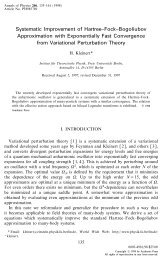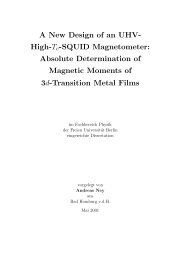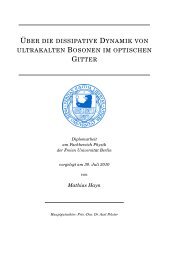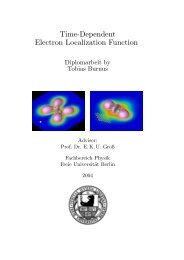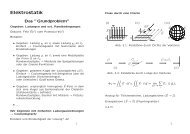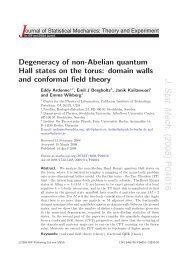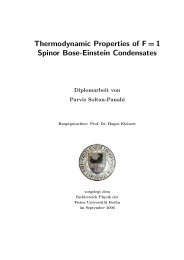Diploma thesis
Diploma thesis
Diploma thesis
Create successful ePaper yourself
Turn your PDF publications into a flip-book with our unique Google optimized e-Paper software.
4.3 Densities<br />
Figs. 4.2(a)–4.2(l) show qualitatively an analogous behaviour for the energies of the harmonic<br />
potential as for the square well except the fact that here the real part of the energy yields ε R =<br />
2m−1 instead of m 2 . The imaginary part of the energy is always non-positive which confirms that<br />
our imaginary potential model really describes a damping effect and thus dissipation. Furthermore<br />
we can separate all states in two groups of n-states and k-states again, where we resumed the<br />
notation of the last chapter which means lim c→∞ ε k I = 0 and lim c→∞ ε n I = −∞. Also the well<br />
known fusion of always two adjoining k-states is a property of the harmonic potential and an<br />
effect of its natural symmetry, as well as the interchange of states being k- or n-state at some<br />
waists ω crit . Observing the imaginary parts of the k-states reveals again a minimum so we can<br />
see that after it ε k I indeed increases to zero. Unfortunately we can not derive the analogon of this<br />
for the n-states that is a maximum of ε n I + c. This is related to the behaviour of the left hand<br />
side of (4.37) and (4.80) which yields an increasing effort of the numerical calculation for large<br />
values of c and ω for the n-states. So the numerical evaluation of the n-states for large waists and<br />
dissipations can unfortunately not be included in this diploma <strong>thesis</strong>.<br />
Nevertheless we know from the last chapter that the limit ω → ∞ yields finite values for ε n R and<br />
there is some additional evidence that also c → ∞ is followed by finite results. We can take for<br />
instance the obvious analogy of all results to the square well potential where a finite saturation<br />
value exists which we even can calculate. Moreover we found out that the imaginary potential<br />
does not directly affect the real part of the energy but yields the same effect as a potential barrier<br />
confining the n-states in a square well potential with the width 2w for c → ∞. Thus the ε n R<br />
become the real energies of states of exactly this potential well and should be therefore finite. The<br />
general situation actually did not change since the harmonic potential becomes a square well one<br />
for c → ∞ and w = const. < ∞. So the assumption, that also in the harmonic case a kind of<br />
independent potential well containing states with finite energy eigenvalues develops, seems to be<br />
reasonable. We will have a deeper look at exactly this issue while discussing the corresponding<br />
densities of the energies.<br />
4.3 Densities<br />
Taking (4.35) and (4.78) we can calculate via (4.21) the densities for given c and ω:<br />
57




